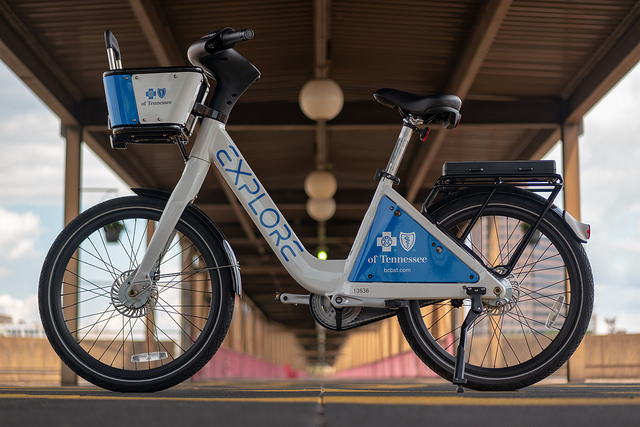TREC x PSU: Breaking Barriers to Bike Share Briefs
by Farrah Daniel, Better Bike Share Partnership Writer
August 19, 2020

The mission to make bike share more accessible and equitable is a lifelong commitment — and those apart of this driven purpose work tirelessly to provide resources or be one themselves.
One generous contributor to the work of improving bike share equity is The Transportation Research and Education Center (TREC) at Portland State University (PSU), which has been established by TREC-affiliated researchers as a center to better understand how to make bike share more equitable. Home to the National Institute for Transportation and Communities (NITC) and other transportation grants and programs, TREC’s aim is to create illuminating research for transportation industry decision-makers as well as “support the education of future transportation professionals through curriculum development and student participation in research.”
Between reports, articles and presentations, TREC is a premier platform for providing insights on who uses bike share, how to engage underserved communities and how cities can serve those communities with bike share. If you’re interested in learning more, check out their Breaking Barriers to Bike Share research, which reviews bike share systems in Philadelphia, Chicago and Brooklyn to understand the barriers and potential motivators to lower-income residents and people of color using bike share.
Today, we’re highlighting the newly published set of bike share briefs, whose recommendations were adapted from the National Scan of Bike Share Equity Programs, a 130-page report created to learn about programs and initiatives addressing equity in bike share.
Additionally, this report has also helped cities and operators learn from the experiences of others and work to achieve greater equity in bike share.
These are the PSU researchers who worked on these projects:
- Joseph Broach, Adjunct Research Associate
- Jennifer Dill, Professor
- John MacArthur, Sustainable Transportation Program Manager
- Nathan McNeil, Research Associate
- Austin Cummings, PSU Student Researcher
Ready to explore effective ways to break barriers to bike share for people of color and residents of underserved communities?
Breaking Barriers to Bike Share Briefs
As we mentioned before, these bike share briefs were adapted from TREC’s National Scan of Bike Share Equity Programs report and are part of the Breaking Barriers to Bike Share resource series.
Through 10 vital topics, these briefs scrutinize bike share through an equity lens and provide an inside look into the cities addressing these topics and barriers, and they especially share successful approaches and recommendations for stakeholders to keep in mind as you conceptualize or implement a bike share equity program.
Here’s what you can expect to learn in each two-pager.
Equity Policies
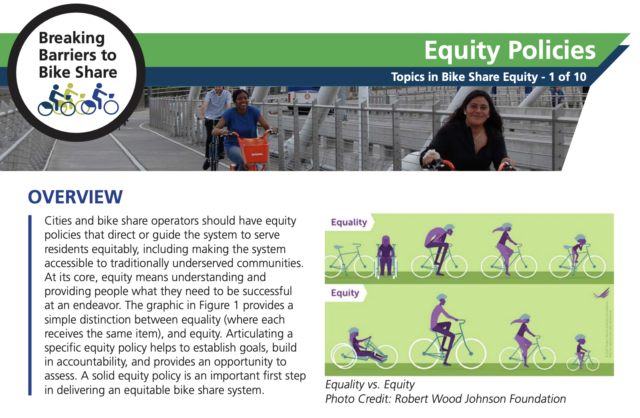
A solid equity policy is an important first step in delivering an equitable bike share system. Additionally, articulating specific equity policies help establish goals, build in accountability and provides an opportunity to assess.
Cities and bike share operators should have equity policies that direct or guide the system to serve residents equitably, including making the system accessible to traditionally underserved communities. At its core, equity means understanding and providing people what they need to be successful at an endeavor.
View the Equity Policies two-pager.
Funding Equity Work
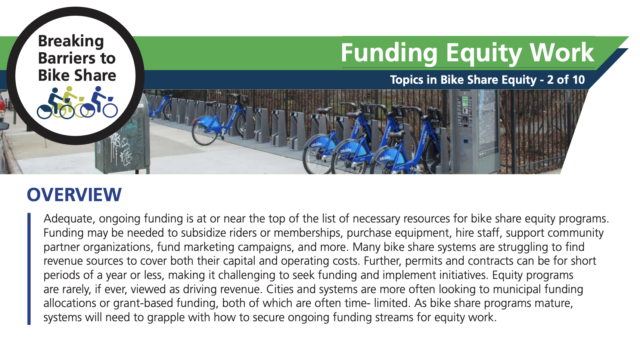
Adequate, ongoing funding is at the top of the list of necessary resources for bike share equity programs that need assistance to subsidize riders or memberships, purchase equipment, hire staff, support community partner organizations, fund marketing campaigns and more. Unfortunately, many bike share systems struggle to find revenue sources to cover both their capital and operating costs.
Further, permits and contracts can be for short periods of a year or less, which makes it challenging to seek funding and implement initiatives. Equity programs are rarely viewed as revenue drivers; rather, cities and systems more often look to municipal funding allocations or grant-based funding, both of which are often time-limited. As bike share programs mature, systems will need to grapple with how to secure ongoing funding streams for equity work.
View the Funding Equity Work two-pager.
Workforce Development

Running an equitable bike share system starts with equitable practices at the hiring stage and in ongoing training of staff. Many operators have made explicit commitments to hiring a diverse workforce. One element of this commitment is providing training and employment opportunities to individuals from lower-income and disadvantaged communities.
View the Workforce Development two-pager.
Marketing
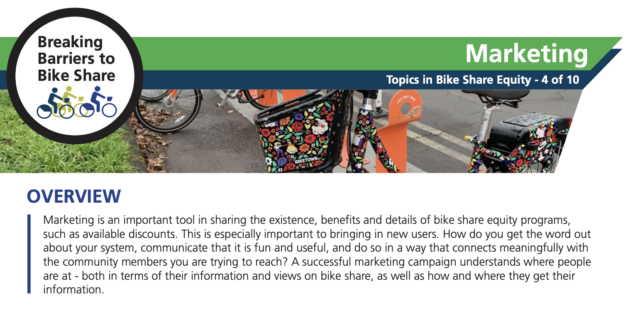
How do you spread the word about your system to communicate that it’s fun and useful, and do so in a way that connects meaningfully with the community members you’re trying to reach?
Marketing! It’s an important tool in sharing the existence, benefits and details of bike share equity programs, and it’s especially important to bring in new users. A successful marketing campaign understands where people are, both in terms of their information and views on bike share as well as how and where they get their information.
View the Marketing two-pager.
Data Collection and Metrics

Well-considered data metrics should enable bike share operators to identify equity gaps and to support program evaluation, including what is working, what isn’t and why. However, common sources of data for many systems, like periodic member surveys and usage data, may not be enough to measure progress toward equity goals.
Challenges include finding staff or partners with the skills to collect and analyze data as well as paying for evaluation given already limited funding. Plus, the limited duration of most equity programming makes it hard to gather consistent data over time, even though that’s what is needed to better measure equity outcomes.
View the Data Collection and Metrics two-pager.
Community Partnerships
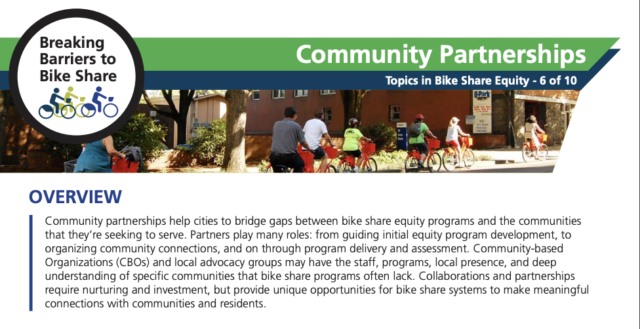
Community-based Organizations (CBOs) and local advocacy groups often have the staff, programs, local presence and deep understanding of specific communities that bike share programs often lack. Collaborations and partnerships require nurturing and investment, but they provide unique opportunities for bike share systems to make meaningful connections with communities and residents.
While partners play many roles — from guiding initial equity program development to organizing community connections, to program delivery and assessment — community partnerships help cities to bridge gaps between bike share equity programs and the communities they seek to serve.
View the Community Partnerships two-pager.
Payment and Access Technology
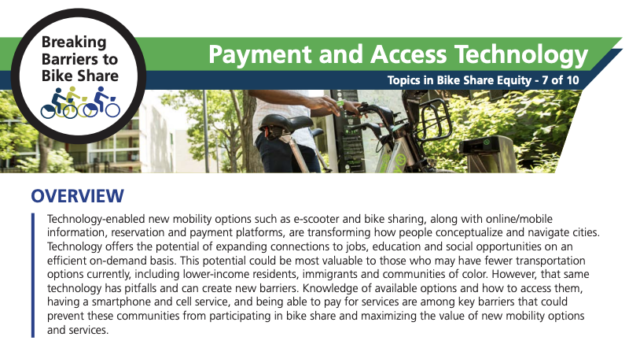
New technology-enabled mobility options and innovations (i.e., reservation and payment platforms) are transforming how people conceptualize and navigate cities. Technology offers the potential of expanding connections to jobs, education and social opportunities on an efficient on-demand basis. And this potential could be most valuable to people with fewer transportation options, including lower-income residents, immigrants and communities of color.
At the same time, the same technology has pitfalls and can create new barriers. These are some key barriers that could prevent these communities from participating in bike share and maximizing the value of new mobility options and services:
- Lack of knowledge of available options and how to access them
- Lack of access to a smartphone and/or cell service
- Inability to pay for services
View the Payment and Access Technology two-pager.
Integrating Bike Share and Transit
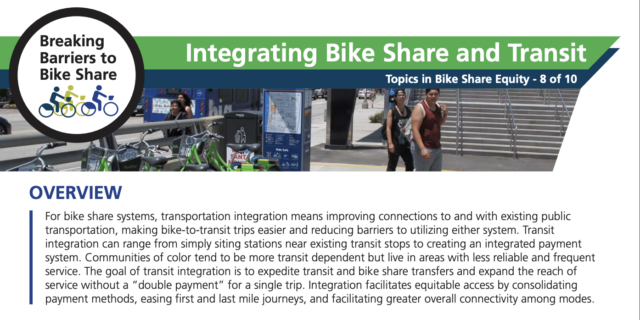
Communities of color tend to be more transit-dependent yet live in areas with less reliable and frequent service. The goal of transit integration (i.e., siting stations near existing transit stops or creating an integrated payment system) is to facilitate greater overall connectivity among modes and expand the reach of service without a “double payment” for a single trip.
For bike share systems, transportation integration means improving connections to and with existing public transportation, easing first and last-mile journeys, making bike-to-transit trips easier and reducing barriers to utilizing either system.
View the Integrating Bike Share and Transit two-pager.
Emerging Devices in New Mobility
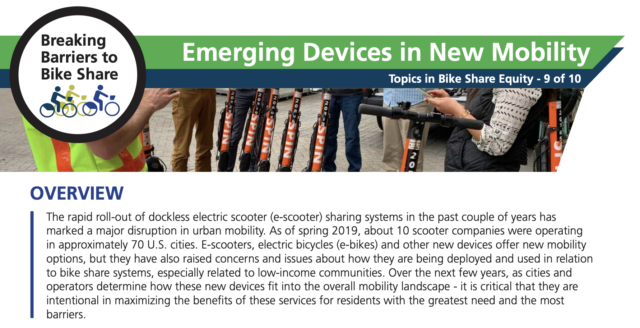
The rapid roll-out of dockless e-scooter sharing systems in the past couple of years has marked a major disruption in urban mobility. E-scooters, e-bikes and other new devices offer new mobility options, but they also raise concerns about how they’re being deployed and used in relation to bike share systems, especially for low-income communities.
As cities and operators determine how these new devices fit into the overall mobility landscape, it’s critical that they’re intentional in how they maximize the benefits of these services for residents with the greatest need and the most barriers.
View the Emerging Devices in New Mobility two-pager.
Adaptive Bike Share

Bike share systems are exploring the right way to include accessible options but are challenged by cost, resources, bicycle types, program implementation and infrastructure.
For people with disabilities and older adults, limited mobility can mean limited independence and fewer opportunities to engage in physical and social activities. Older adults and people with disabilities often make fewer trips than they would like to because they lack adequate transportation, and adaptive bike share has the potential to make cycling a real option for them.
View the Adaptive Bike Share two-pager.
— — — — — — —
Thank you to Cait McCusker for designing the Breaking Barriers to Bike Share Briefs!
Brush up on these informative briefs and stay tuned! Next, we’re talking with PSU researchers Nathan McNeil and John MacArthur to get a behind-the-scenes look into what it took to both create the National Scan of Bike Share Equity Programs report in 2019 and adapt 10 bike share briefs from them.
In the meantime, talk to us on Twitter, Facebook or Instagram about these briefs. What have you learned so far about bike share equity?
The Better Bike Share Partnership is a JPB Foundation-funded collaboration between the City of Philadelphia, the Bicycle Coalition of Greater Philadelphia, the National Association of City Transportation Officials (NACTO) and the PeopleForBikes Foundation to build equitable and replicable bike share systems. Follow us on Facebook, Twitter and Instagram or sign up for our weekly newsletter. Story tip? Write farrah@peopleforbikes.org


